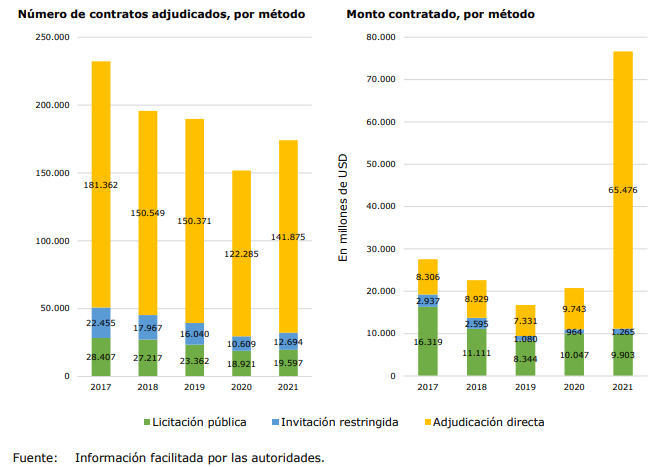Public procurement procedures in Mexico can be carried out in person, electronically through the CompraNet platform or in a mixed manner.
According to the authorities, in 2020 70% were carried out on CompraNet, 18% in person and 12% in mixed form.
In 2019, the Federal Government Digital Store (TDGF) was created on the CompraNet platform to carry out purchases of goods and services subject to framework contracts.
Datos de contratación pública, por método de contratación, 2017-2021
According to the World Trade Organization (WTO), public procurement accounted for 2.4% of Mexico’s GDP and 10.1% of public spending in 2017, while in 2020 those percentages were 1.9% and 7.4%, respectively.
Then, in 2021, government procurement increased to US$76.644 billion, i.e., it represented 5.9% of GDP and 23.1% of public spending.
This increase is due to the purchase of medicines, medical materials/equipment and hygienic products due to the health emergency.
Between 2017 and 2021, direct award was the method by which the largest number of contracts were awarded.
In terms of value, most purchases are still awarded through public tenders, although there has been an increase in the use of direct award.
Public procurement
In 2021, 85% of public procurement was carried out through direct awards.
In a public bidding process, contracts for goods and services are awarded based on one of three criteria: the bid with the best cost-benefit ratio; the bid with the highest score; or the bid with the lowest price.
Under the cost-benefit and scoring criteria, the lowest price is not necessarily decisive.
The lowest price criterion is used if the other two criteria cannot be used.
Moreover, all other things being equal, preference is given to MSMEs.
In general, works contracts are awarded to the most «solvent» offer, i.e., the conditions offered by the supplier guarantee the execution of the contract.
All things being equal, in open international public bidding processes for the acquisition of goods, preference is given to goods of national origin.
In addition, a margin of preference of 15% continues to be given to goods of national origin.
![]()

